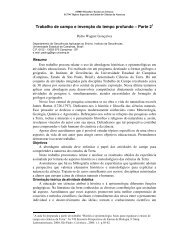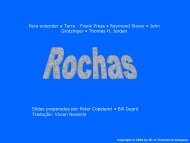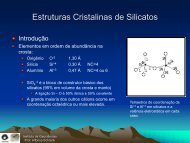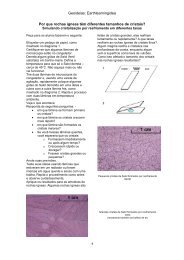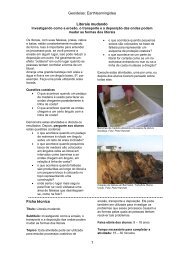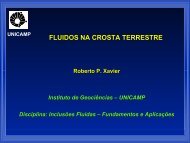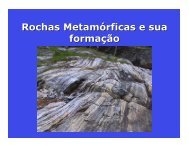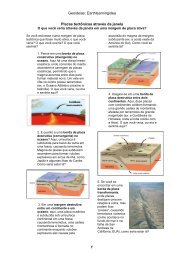Q-<strong>Mode</strong> And R-<strong>Mode</strong> <strong>Factor</strong> <strong>Analysis</strong> In <strong>Quantitative</strong> <strong>Studies</strong> Of Micr<strong>of</strong>ossilsTERRÆ 7(1-2):41-49, 2010can be expla<strong>in</strong>ed by their different function. Once<strong>in</strong>terested <strong>in</strong> along time samples <strong>in</strong>ter-relationshipsQ-mode technique should be chosen, however, ifspecies <strong>in</strong>ter-relationship is enquired, then R-modewould be more appropriate.We believe that as long as we are <strong>in</strong>terested <strong>in</strong>improv<strong>in</strong>g paleoceanographic <strong>in</strong>ferences based onmar<strong>in</strong>e micropaleontological quantitative data sets,Q-mode factor analysis is recommended. Q-modetemporal elucidation, its higher reliability regard<strong>in</strong>gcorrelation coefficients <strong>and</strong> its f<strong>in</strong>est <strong>in</strong>terpretableresults are some advantages po<strong>in</strong>ted out over theR-mode technique.The complete data set from statistical analysisare available at: http://lapas-io.blogspot.com/2010/10/tabelas-do-artigo-hirama-et-al-2010.html6. AcknowledgmentsWe would like to express our thanks to MariaGomez Pivel for helpful discussions on earlierversion <strong>of</strong> this manuscript. This study was f<strong>in</strong>anciallysupported by FAPESP (Fundação de Amparoà Pesquisa do Estado de São Paulo), process04/02819-8. We thank Petrobras for provid<strong>in</strong>g thesamples. This is Laboratório de Paleoceanografia doAtlântico Sul (LaPAS) contribution number 13.Figure 8 – SAN-76 R-mode factors 1 to 11 scores, oxygenisotopic curve <strong>and</strong> planktonic foram<strong>in</strong>ifera determ<strong>in</strong>edzones Z (<strong>in</strong>terglacial) <strong>and</strong> Y (glacial)7. ReferencesAndreasen, D.J. & Ravelo, A.C. 1997. Tropical PacificOcean thermocl<strong>in</strong>e depth reconstructions forthe last glacial maximum. Paleoceanography, 12(3): 395-413.Andruleit, H., Rogalla, U. & Stäger, S. 2004. Fromliv<strong>in</strong>g communities to fossil assemblages: orig<strong>in</strong><strong>and</strong> fate <strong>of</strong> coccolithophores <strong>in</strong> the northernArabian Sea. Micropaleontology, 50 (1), 5-21.Bown, P.R. & Young, J.R. 1998. Techniques. In: P.R.Bown (Ed.). Calcareous Nann<strong>of</strong>ossil Biostratigraphy.Kluwer Academic Publishers. p. 16-28.Bradley, R.S. 1999. Mar<strong>in</strong>e sediments <strong>and</strong> corals. In:R.S. BRADLEY. Paleoclimatology – reconstruct<strong>in</strong>gclimates <strong>of</strong> the Quaternary. Burl<strong>in</strong>gton: ElsevierAcademic Press. p.191-283.Br<strong>and</strong>, L.E. 1994. Physiological ecology <strong>of</strong> mar<strong>in</strong>ecoccolithophores. In: A. W<strong>in</strong>ter & W. Siesser(eds.). Coccolithophores. Cambridge: CambridgeUniversity Press, p. 39-49.48a5_t7.<strong>in</strong>dd 48 27/01/2011 11:28:07
TERRÆ 7(1-2):41-49, 2010Hirama, M. V., Toledo, F. A. de L., Junior, E. C., Costa, K. B., Quadros, J. P. deBuccheri, G., Capretto, G., Di Donato, V., Esposito,P., Ferruzza, G., Pescatore, T., Ermolli, E. R.,Senatore, M. R., Sprovieri, M., Bertoldo, M.,Carella, D. & Madonia, G. 2002. A high resolutionrecordo f the last deglaciation <strong>in</strong> the southernTyrrhenian Sea: environmental <strong>and</strong> climaticevolution. Mar<strong>in</strong>e Geology, 186:447-470.Buccianti, A. & Esposito, P. 2004. Insights <strong>in</strong>toLate Quaternary calcareous nannoplanktonassemblages under the theory <strong>of</strong> statisticalanalysis for compositional data. Palaeogeography,Palaeoclimatology, Palaeoecology, 202:209-227.CLIMAP. 1981. Seasonal Reconstructions <strong>of</strong> theEarth’s Surface at the Last Glacial Maximum.Geological Society <strong>of</strong> America Map <strong>and</strong> Chart Series,MC-36: 1-18.Fairbanks, R.G.; Sverdlove, M.; Free, R.; Wiebe,P.H.; & Be, A.W.H. 1982. Vertical distribution<strong>and</strong> isotopic fractionation <strong>of</strong> liv<strong>in</strong>g planktonicforam<strong>in</strong>ifera from the Panama Bas<strong>in</strong>. Nature,298: 841-844.Figueiredo, N. M. S. 1996. <strong>Mode</strong>rnização, distribuiçãoda renda e pobreza na agricultura brasileira 1975,1980 e 1995. Piracicaba: Escola Sup. Agric. “Luizde Queirós”, Univ. de São Paulo. 248p. (TeseDout.).Gouvêa, M. A. 2003. Análise fatorial. Nível pósgraduação.São Paulo: Fac. Economia eAdm<strong>in</strong>istração, Universidade de São Paulo.Gupta, B.K.S. 1999. <strong>Mode</strong>rn Foram<strong>in</strong>ifera. KlüwerAcademic Publishers. 372p.Harman, H. H. 1976. <strong>Mode</strong>rn factor analysis. Chicago:Univ. <strong>of</strong> Chicago Press.Heleben, C., Sp<strong>in</strong>der, M. & Eerson, O.R. 1989.<strong>Mode</strong>rn Planktonic Foram<strong>in</strong>ifera. Spr<strong>in</strong>ger-Verlag,Berl<strong>in</strong>.Hilbrecht, H. 1996. Extant planktic foram<strong>in</strong>ifera <strong>and</strong> thephysical environment <strong>in</strong> the Atlantic <strong>and</strong> Indian Oceans.Mitteilungen aus dem Geologisschen Institutder Eidgen. Zürich, Technischen Hochschuleund der Universität Zürich, Neue Folge. n.3000, 93 p.K<strong>in</strong>kel, H., Baumann, K.-H. & Cepek, M. 2000.Coccolithophores <strong>in</strong> the equatorial AtlanticOcean: response to seasonal <strong>and</strong> Late Quaternarysurface water variability. Mar<strong>in</strong>e Micropaleontology,39:87-112.Kucera, M. 2003. Numerical approach to micr<strong>of</strong>ossilproxy data. Lecture notes for Summer SchoolPaleoceanography: theory <strong>and</strong> field evidence. IAMCGeomare 2003, pp.66-90.Molf<strong>in</strong>o, B. & McIntyre, A. 1990. PrecessionalForc<strong>in</strong>g <strong>of</strong> Nutricl<strong>in</strong>e Dynamics <strong>in</strong> the EquatorialAtlantic. Science, 249:766-769.Okada, H. 1992. Biogeographic control <strong>of</strong> modernnann<strong>of</strong>ossil assemblages <strong>in</strong> surface sediments <strong>of</strong>Ise Bay, Mikawa Bay e Kumano-Nada, <strong>of</strong>f coast<strong>of</strong> central Japan. Memorie di Scienze Geologiche,43:431-449.Okada, H. & Honjo, S. 1973. The distribution <strong>of</strong>oceanic coccolithophorids <strong>in</strong> the Pacific. Deep-Sea Research, 20:355-374.Ravelo, A.C., Fairbanks, R.G. & Phil<strong>and</strong>er, S.G. 1990.Reconstruct<strong>in</strong>g tropical Atlantic hydrographyus<strong>in</strong>g planktonic foram<strong>in</strong>ifera <strong>and</strong> an oceanmodel. Paleoceanography, 5(3):409-431.Roth, P. 1994. Distribution <strong>of</strong> coccoliths <strong>in</strong> oceanicsediments. In: A. W<strong>in</strong>ter & W. Siesser (eds.).Coccolithophores. Cambridge: Cambridge Univ.Press. p. 199-218.Schmidt, D. A., Renaud, S., Bollmann, J., Schiebel,R. & Thierste<strong>in</strong>, H. R. 2003. Size distribution<strong>of</strong> Holocene planktic foram<strong>in</strong>ifer assemblages:biogeography, ecology <strong>and</strong> adaptation. Mar<strong>in</strong>eMicropaleonology, 956:1-20.Toledo, F.A.L. 2000. Variações Paleoceanográficas nosúltimos 30.000 anos no oeste do Atlântico Sul: isótoposde oxigênio, assembléias de foram<strong>in</strong>íferos planctônicose nan<strong>of</strong>ósseis calcários. Porto Alegre: Inst. Geoc.Universidade Federal do Rio Gr<strong>and</strong>e do Sul.245p. (Tese Dout.)Toledo, F.A.L., Cachão, M., Costa, K.B. & Pivel,M.A.G. 2007. Planktonic foram<strong>in</strong>ifera, calcareousnannoplankton <strong>and</strong> ascidian variations dur<strong>in</strong>g the last 25kyr <strong>in</strong> the Southwestern Atlantic: a paleoproductivitysignature? Mar<strong>in</strong>e Micropaleontology, doi: 10.1016/j.marmicro.2007.03.001.Toledo, F.A.L., Ayup-Zoua<strong>in</strong>, R.N. & Costa, K.C. 1999.Análise fatorial (modo-Q) em estudos quantitativosde nan<strong>of</strong>ósseis calcários do Quaternário superiorem um testemunho da Bacia de Campos, RJ-Brasil.Pesquisas, 26(2):62-72.49a5_t7.<strong>in</strong>dd 49 27/01/2011 11:28:08



